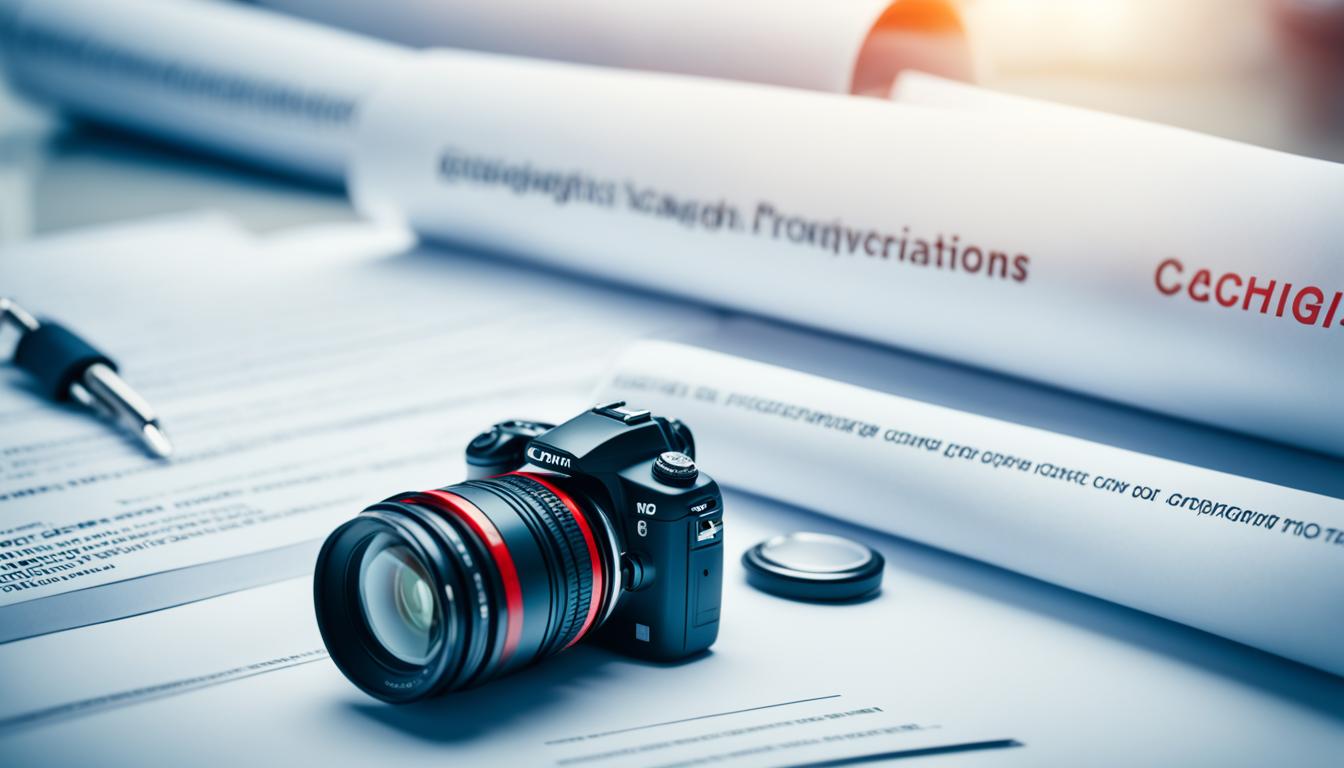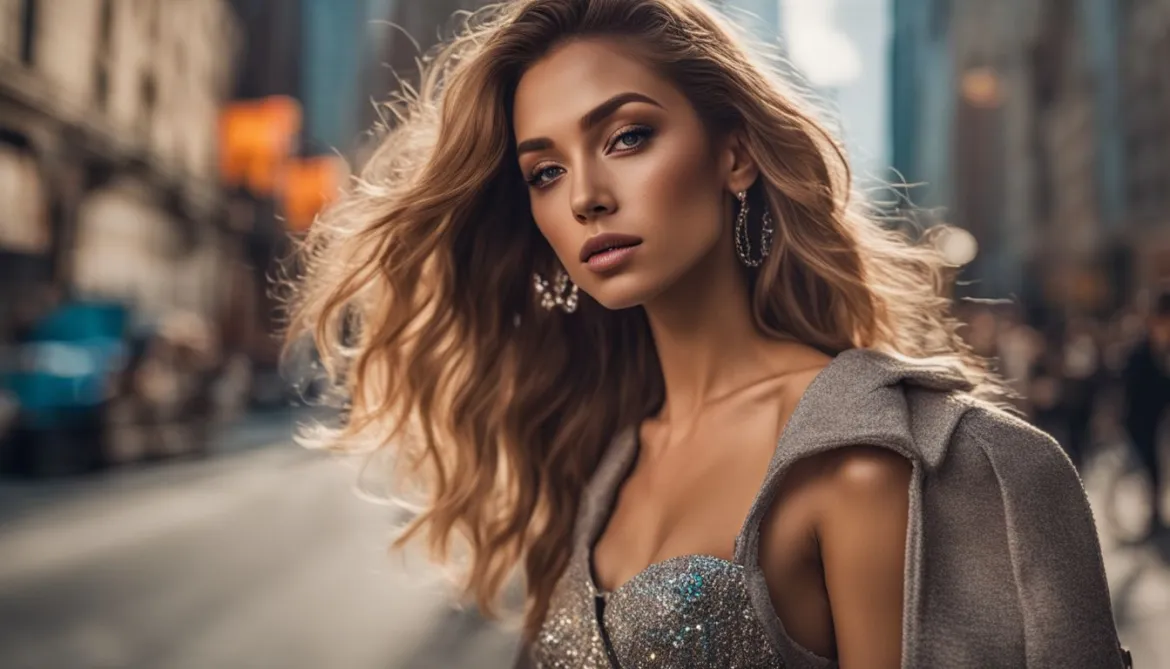Welcome to our guide on navigating copyrights in editorial photography. In this article, we will explore the legal considerations and image rights that photographers need to be aware of in order to protect their work and avoid copyright infringement. Understanding the complexities of intellectual property law, photographer’s rights, licensing agreements, and copyright protection is vital for any photographer in the editorial industry.
Editorial photography involves capturing images that tell a story or convey information within a journalistic or documentary context. These images are often used in newspapers, magazines, online news platforms, and other editorial publications. As a photographer, it is crucial to navigate the intricacies of copyrights to ensure that your work is protected and used appropriately.
The regulations surrounding copyright infringement in editorial photography can be complex. It is essential to understand the rights and permissions associated with using someone else’s copyrighted material, as well as how to protect your own copyrighted work. By adhering to copyright regulations, photographers can maintain the integrity of their images and avoid legal disputes.
In the following sections, we will delve into the different aspects of copyright in editorial photography, including understanding copyright laws and permissions, obtaining and using images legally, utilizing stock imagery and free images, considering copyright implications in different contexts, and following best practices for image usage. By familiarizing yourself with these topics, you can navigate copyright regulations and protect your work in the editorial photography industry.
Key Takeaways:
- Understanding copyright laws and permissions is crucial in editorial photography.
- Obtaining necessary permissions and licenses is essential for legal image usage.
- Stock imagery and free images can be valuable resources, but caution must be exercised in understanding licensing terms.
- Copyright considerations can vary depending on the context of image usage.
- Following best practices, such as proper attribution and obtaining model releases, is essential for copyright compliance.
Understanding Copyright Laws and Permissions
When it comes to protecting your creative work, copyright laws play a crucial role. This section will provide you with a comprehensive understanding of copyright laws, permissions, and the concept of fair use in the context of editorial photography. By familiarizing yourself with these principles, you can navigate the legal landscape of image usage and ensure compliance with copyright protection.
The Basics of Copyright Laws
Copyright laws grant exclusive rights to the creator of an original work, such as a photograph. These laws protect photographers by giving them control over how their images are used and distributed. It is essential to respect these rights and understand the legal framework surrounding copyright protection.
Permissions and Image Usage
When using copyrighted images, it is crucial to obtain proper permissions. This typically involves seeking the consent of the copyright owner before using their work. By obtaining permissions, photographers can legally use copyrighted images in their editorial projects, ensuring they respect the rights of the original creator.
The Concept of Fair Use
Fair use is a legal doctrine that allows limited use of copyrighted material without permission from the copyright owner. However, fair use is a complex concept and can vary depending on factors such as the purpose and nature of the use, the amount and substantiality of the portion used, and the effect on the market for the original work. Understanding fair use guidelines will help you navigate the boundaries of using copyrighted material in your editorial photography.
“Copyright laws provide the necessary legal framework to protect photographers’ rights and promote creativity.”
By familiarizing yourself with copyright laws, obtaining permissions, and understanding fair use, you can confidently and legally use copyrighted images in your editorial photography projects.
| Key Points | Benefits |
|---|---|
| Understanding copyright laws | Ensure compliance and avoid infringement |
| Obtaining proper permissions | Legally use copyrighted images |
| Concept of fair use | Navigate boundaries of image usage |
Obtaining and Using Images Legally
In order to ensure legal use of images in editorial photography, it is imperative to obtain the necessary permissions and licenses. This section will guide you through the essential steps of obtaining images legally, ensuring that you are operating within the bounds of copyright law and respecting the rights of others.
Determining Copyright Ownership
Before using any image, it is important to determine the copyright ownership. Whether you are working with your own photographs or sourcing from other photographers, understanding who owns the rights to the image is crucial. This can be done by checking the metadata or contacting the copyright holder directly.
Obtaining Model Releases
When featuring recognizable individuals in your editorial photographs, it is necessary to obtain a model release. This legal document grants you permission to use the individual’s likeness in your work. Protect yourself and ensure that you have obtained the appropriate model releases for everyone featured in your images.
Licensing Agreements
Acquiring licenses for the use of images is another important aspect of using photographs legally. Licensing agreements outline the terms and conditions for using an image and specify whether it can be used for commercial purposes. Be sure to obtain the appropriate licenses to avoid any copyright infringement issues.
Use of Public Domain Images
Public domain images are those that are not protected by copyright, or whose copyright has expired. They can be freely used and do not require permission or licensing. However, it is important to understand the limitations and restrictions that may apply to different public domain images. Always ensure that the image you choose is truly in the public domain.
Using images legally is essential for photographers in the editorial industry. By obtaining the necessary permissions, determining copyright ownership, and understanding licensing agreements, you can protect your work, respect the rights of others, and maintain compliance with copyright law.

Using Stock Imagery and Free Images
When it comes to finding the perfect visuals for your editorial photography, stock imagery and free images can be incredibly useful resources. Whether you’re looking for high-quality photos or specific themes, these options offer a wide range of choices for your creative needs.
The Benefits of Stock Imagery
Stock imagery platforms provide photographers with a vast library of professionally captured images. These platforms offer a diverse range of subjects, styles, and resolutions to suit different editorial projects. By utilizing stock imagery, photographers can save time and effort spent on extensive photoshoots and gain access to a wide variety of images for commercial use.
One of the key advantages of stock imagery is the convenience it offers. You can easily search for specific themes, concepts, or keywords to find relevant visuals for your articles or publications. Additionally, these platforms often provide helpful filters and categorization options to streamline the search process further.
H3: Licensing Terms and Attribution
Understanding licensing terms is crucial when using stock imagery for commercial purposes. Each stock photography platform has its own licensing agreements and usage terms, which may vary depending on the chosen license type. It’s important to carefully review and adhere to these terms to ensure proper usage rights and avoid copyright infringement.
When using stock imagery, attribution may or may not be required, depending on the specific licensing terms. Attribution typically involves giving credit to the original photographer or the stock imagery platform. To ensure compliance and ethical use, always check the licensing terms and follow the required attribution guidelines.
Caution when using Free Images
“Free” doesn’t always mean “completely unrestricted.”
While free images can be an attractive option for editorial photographers on a budget, it’s important to exercise caution when using them for commercial purposes. Some free images may have licensing restrictions or limitations on commercial use, so it’s essential to thoroughly read and understand the licensing terms. Failure to adhere to these terms can result in copyright infringement.
Additionally, it’s worth noting that free images may have limitations in terms of quality, resolution, or availability of different subject matter. Therefore, it’s crucial to assess the suitability of these images for your specific editorial needs before incorporating them into your work.
Proper Attribution and Compliance
Regardless of whether you’re using stock imagery or free images, proper attribution and compliance with licensing terms are vital. By crediting the original photographer or the image source, you acknowledge their creative work and uphold ethical standards within the industry.
When using stock imagery or free images, always check the attribution requirements specified in the licensing terms. This ensures you provide the appropriate credit and avoid any potential legal issues related to copyright infringement.
Here is a table summarizing the key considerations when using stock imagery and free images in editorial photography:
| Consideration | Stock Imagery | Free Images |
|---|---|---|
| Licensing Terms | Varies based on platform and license type | Varies; be cautious of restrictions on commercial use |
| Attribution | May or may not be required; check licensing terms | May or may not be required; check licensing terms |
| Quality and Selection | Diverse range of high-quality images | Varies; limitations in quality and subject matter |
By understanding the benefits, licensing terms, and proper usage of stock imagery and free images, editorial photographers can enhance their creative work while respecting copyright laws and protecting the rights of photographers and image creators.
Copyright Considerations in Different Contexts
When it comes to using images in different contexts, photographers need to be aware of the copyright implications involved. Understanding the specific copyright considerations in each context will help photographers make informed decisions and avoid potential legal issues related to copyright infringement.
Commercial Use
Commercial use of images refers to the use of photographs for promotional or profit-generating purposes. This can include using images in advertisements, marketing campaigns, product packaging, and more. When using images for commercial purposes, photographers must ensure they have the necessary permissions and licenses from the copyright owner.
Editorial Use
Editorial use of images involves using photographs for news reporting, educational purposes, or in non-commercial publications such as newspapers, magazines, and blogs. While editorial use allows for the use of copyrighted images without explicit permission in certain cases, it is important to adhere to fair use guidelines and provide proper attribution to the copyright owner.
Fine Art Photography
Fine art photography allows photographers to express their artistic vision and create photographs as artistic works. When it comes to fine art photography, copyright ownership becomes especially crucial. Photographers should ensure they have copyright ownership of their work and understand any limitations or restrictions on its use, including for exhibition or sale.
Photography for Sale
When photographers sell their photographs, they need to consider copyright ownership and licensing agreements. If photographers wish to retain copyright ownership, they may choose to license their images for specific uses, such as prints or commercial licensing. By clearly defining the terms of use through licensing agreements, photographers can protect their copyright and ensure that their work is used appropriately.
Understanding the specific copyright considerations in each context will help photographers make informed decisions and avoid legal issues related to copyright infringement.
Best Practices for Image Usage in Editorial Photography
When it comes to image usage in editorial photography, following best practices is crucial for copyright compliance and maintaining ethical standards. In this section, we will outline key best practices that photographers should adhere to in order to protect their work, respect the rights of others, and ensure compliance with copyright laws.
Proper Attribution
One of the fundamental best practices in editorial photography is providing proper attribution for the images used. This involves crediting the original photographer or copyright owner whenever an image is published or shared. By acknowledging the source of the image, you not only show respect for the creator but also demonstrate your commitment to copyright compliance.
Whether it’s a photo credit line, watermark, or embedded metadata, make sure to include the necessary attribution information alongside the image. This can typically include the name of the photographer, copyright symbol, and the year of creation. By doing so, you provide transparency and ensure that the image is appropriately credited.
Obtaining Necessary Permissions
Prior to using any image in editorial photography, it is essential to obtain the necessary permissions from the copyright owner. This typically involves obtaining a licensing agreement that outlines the terms and conditions of image usage. The agreement may specify the duration of use, geographical coverage, and any restrictions or limitations regarding commercial use.
By obtaining proper permissions, you reduce the risk of copyright infringement and legal repercussions. It also demonstrates your commitment to upholding copyright laws and respecting the rights of content creators. Remember, always obtain written permission and keep a record of the licensing agreements for future reference.
Securing Model Releases
When including recognizable individuals in your editorial photography, obtaining model releases is essential. A model release is a legal document that grants you permission to use the individual’s likeness for commercial or editorial purposes. This document protects both the photographer and the model and ensures that each party’s rights and interests are respected.
Make sure to explain the purpose of the shoot and the intended use of the images to the models clearly. Obtain their consent in writing, including their signature and the date. This ensures that you have necessary proof of permission, should any legal situations arise in the future.
Copyright Compliance Checklist
| Best Practices | Checklist |
|---|---|
| Proper Attribution | Include photo credit lines or watermarks |
| Obtaining Necessary Permissions | Secure licensing agreements |
| Securing Model Releases | Obtain written consent from models |
By following these best practices for image usage in editorial photography, you can protect your work, maintain copyright compliance, and build a reputation as an ethical and responsible photographer. Remember, respecting the rights of others and obtaining necessary permissions are essential for a successful and sustainable career in the industry.

Conclusion
Legal considerations and the protection of copyrights and image rights are crucial in the world of editorial photography. By understanding the complexities of copyright laws, obtaining the necessary permissions, and following proper procedures for image usage, photographers can safeguard their work and avoid copyright infringement.
Respecting the rights of others and adhering to copyright regulations play a vital role in maintaining a professional and ethical approach to editorial photography. Obtaining licenses, model releases, and understanding copyright ownership are essential steps in ensuring the legal and proper use of images.
In conclusion, editorial photographers must be well-versed in the legal aspects of their profession. By educating themselves about copyright protection, image rights, and best practices, photographers can navigate the intricacies of copyright laws and contribute to a fair and respectful industry that values creativity and intellectual property. Remember, the preservation of the rights of both photographers and copyright owners is vital to creating a sustainable and ethical environment in editorial photography.
FAQ
What are the legal considerations in navigating copyrights in editorial photography?
Understanding the legal considerations in copyright protection, image rights, and licensing agreements is essential. This includes knowledge of intellectual property law, photographer’s rights, and editorial photography copyright regulations.
What are the basics of copyright laws and permissions in editorial photography?
Copyright laws provide legal protection for original creative works, including photographs. It’s important to understand copyright protection, permissions, and the concept of fair use in order to navigate the legal landscape of image usage in editorial photography.
How can I obtain and use images legally in editorial photography?
To use images legally, it is crucial to obtain necessary permissions and licenses, determine copyright ownership, obtain model releases, and adhere to licensing agreements. Additionally, understanding the availability and usage of public domain images is important.
What are the considerations when using stock imagery and free images in editorial photography?
Using stock imagery from reputable sites and understanding licensing terms is beneficial. When using free images, caution must be exercised, and proper attribution and adherence to licensing terms are essential to avoid copyright infringement.
How do copyright considerations vary in different contexts of editorial photography?
Copyright implications can vary depending on the context of image usage, such as commercial use, editorial use, fine art photography, and photography for sale. Understanding the specific copyright considerations in each context helps photographers make informed decisions and avoid legal issues.
What are the best practices for image usage in editorial photography?
Best practices include proper attribution, obtaining necessary permissions, securing model releases, and following legal procedures for image usage. Following these practices helps protect photographers’ work, respect the rights of others, and maintain compliance with copyright laws.
How Can Copyright Laws Impact Art and Editorial Photography?
Copyright laws can either promote or hinder harmony in art and editorial photography. While they protect artists’ work, they may also restrict creative freedom. It’s essential for photographers to understand these laws to ensure their rights are upheld while still allowing for artistic expression.




